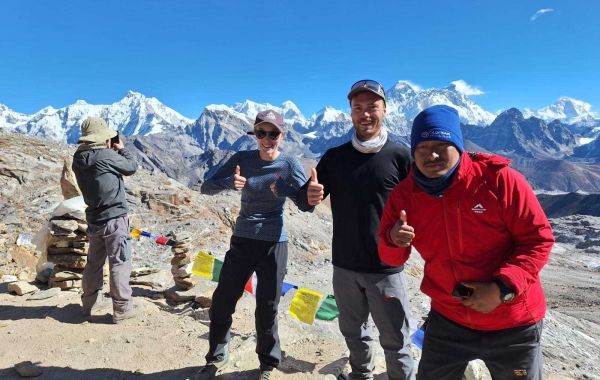The Everest Three High Passes Trek is one of the most thrilling and challenging treks in the Everest region of Nepal. Unlike the more well-known Everest Base Camp (EBC) Trek, the Three High Passes route offers a more adventurous alternative for seasoned trekkers looking to experience the grandeur of the Himalayas in a unique way. This trek involves crossing three significant mountain passes—Renjo La (5,360m), Cho La (5,420m), and Kongma La (5,535m)—making it one of the most rewarding treks in the region.
What makes it unique is its circular route, which allows you to experience all the highlights of the Khumbu Valley, including not only Everest Base Camp but also the stunning Gokyo Lakes, remote villages, and less-traveled trails. This combination of scenic diversity, raw adventure, and fewer crowds sets the Everest Three High Passes Trek apart from other treks in the Everest region.

Route and Highlights:
- Start/End: Lukla
- Key Destinations: Namche Bazaar, Tengboche, Dingboche, Gokyo Lakes, Lobuche, Everest Base Camp, and the three high passes.
- Notable Peaks: Everest, Lhotse, Nuptse, Ama Dablam, Cho Oyu, and Makalu.
- Highlights:Crossing the three challenging high passes.Spectacular views from Gokyo Ri, Kala Patthar, and the summits of each pass.Visiting Everest Base Camp. Exploring the vibrant Sherpa culture and monasteries along the way.
The Three Passes: Renjo La, Cho La, and Kongma La
Each pass offers its own challenges, scenic beauty, and distinct experience.
Renjo La Pass (5,360m)
- Difficulty: Moderate to difficult. Renjo La is the most scenic but slightly less technical compared to the other two passes.
- Scenic Beauty: This pass offers some of the best views of the Gokyo Lakes and the Everest range, including Makalu and Cho Oyu. The trail on the Gokyo side is relatively well-marked, with several viewpoints along the way.
- Key Features: A pristine, panoramic view of the lakes, distant glaciers, and the full grandeur of the Everest region. The descent into the Gokyo Valley is equally stunning, with alpine lakes set against towering peaks.
Cho La Pass (5,420m)
- Difficulty: Cho La is the most technical and strenuous of the three. There’s a significant section of ice and snow, making it quite dangerous during bad weather.
- Scenic Beauty: Stunning vistas of Ama Dablam, Lobuche East, and towering icefalls greet trekkers. The crossing features a sharp, glacier-strewn path, with jagged rocks and icy terrain.
- Key Features: A memorable climb with high exposure to the elements, offering an unforgettable journey across the glacial path and dramatic landscapes.
Kongma La Pass (5,535m)
- Difficulty: Considered the toughest due to its height and the sharp ascent/descent involved.
- Scenic Beauty: Provides panoramic views of Lhotse, Nuptse, and Makalu. From the summit, you can see down to the Khumbu Glacier and up to the Everest range.
- Key Features: A raw, wild trek that offers solitude, stunning vistas, and a deeply rewarding experience as you descend into Lobuche after conquering the pass.

Personal Experience:
Crossing these high passes offers a humbling experience in the face of nature’s grandeur. Each pass is unique, with breathtaking beauty and the constant test of endurance. The thin air, strong winds, and the ever-changing landscape make each crossing a battle of willpower.
Acclimatization and Altitude Sickness
Preparing for High Altitude:
The Everest Three High Passes Trek takes you to extreme altitudes, with many sections above 5,000 meters. Proper preparation is essential, including gradually gaining altitude and taking plenty of acclimatization breaks. Before starting the trek, it’s recommended to spend a few days in Namche Bazaar or Dingboche to allow your body to adjust to the higher altitude.
Importance of Acclimatization Days:
Acclimatization days are crucial to prevent altitude sickness. These are often spent doing side hikes to higher altitudes before descending to sleep at a lower elevation. For example, while in Namche, you might trek up to the Everest View Hotel or Khumjung village.
Signs of Altitude Sickness:
- Mild Symptoms: Headache, nausea, dizziness, and fatigue.
- Severe Symptoms: Difficulty breathing, confusion, and loss of coordination (signs of high-altitude cerebral or pulmonary edema).
Tips to Prevent and Handle Altitude Sickness:
- Trek slowly and steadily.
- Stay hydrated.
- Avoid alcohol and smoking.
- Take medications like Diamox (consult with your doctor beforehand).
- Descend immediately if severe symptoms occur.
Best Time to Do the Everest Three High Passes Trek
Spring (March-May) vs. Autumn (September-November):
- Spring: Warmer temperatures and blooming rhododendrons make this season especially scenic. The trails are slightly busier as trekkers flock to the region to avoid the monsoon and enjoy the milder weather.
- Autumn: This is the most popular time for trekking. The weather is stable with clear skies, offering superb views of the mountains. The cool, crisp air and the lack of precipitation make autumn the perfect time for those who prioritize scenic photography.
Weather Patterns:
- March-May: Day temperatures range between 10°C to 15°C, with colder nights.
- September-November: Day temperatures range from 10°C to 12°C, with even clearer skies and colder nights.
Physical Preparation and Fitness
Fitness Level Required:
The Everest Three High Passes Trek is one of the more strenuous treks in Nepal, requiring high levels of stamina and fitness. Trekkers should be physically fit and comfortable with long hikes, steep ascents, and high-altitude conditions.
Training Tips:
- Cardio: Focus on cardiovascular fitness by doing long hikes, running, swimming, or cycling.
- Strength Training: Build leg and core strength with squats, lunges, step-ups, and core exercises.
- Endurance: Practice long-distance walks with a loaded backpack to mimic the actual trekking conditions.
Recommended Exercises:
- Running or brisk walking: 3–4 times a week to build cardiovascular endurance.
- Hiking: With a backpack to simulate the trek. Include elevation gain to build leg strength.
- Yoga or stretching: To improve flexibility and prevent injury.
Conclusion
The Everest Three High Passes Trek is a demanding but incredibly rewarding adventure that allows you to experience the Everest region from multiple perspectives. Whether it’s the towering peaks, tranquil lakes, or the sheer challenge of crossing these high-altitude passes, the trek offers an experience unlike any other. With the right preparation—both physically and mentally—you can conquer this trek and return with memories that will last a lifetime.








